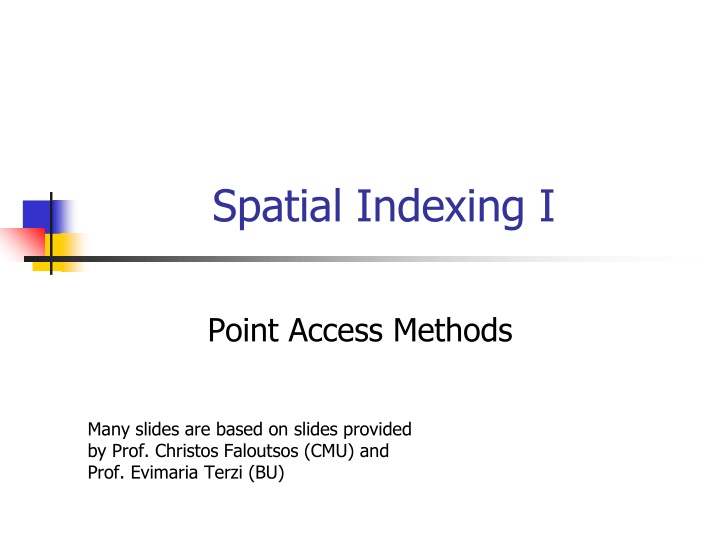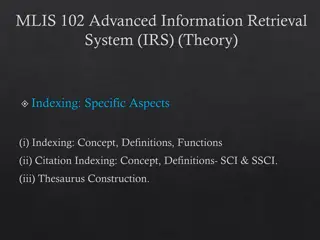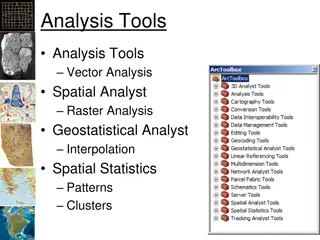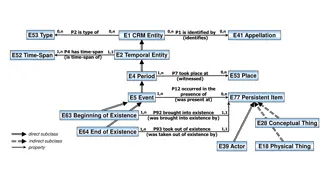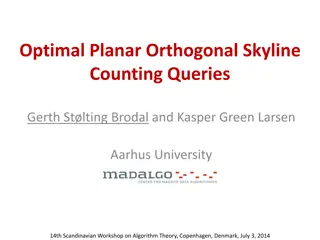Efficient Spatial Indexing Techniques for Range Queries
Explore spatial indexing methods such as grid file, kd-tree, and quadtrees for efficient range query processing. Learn how these methods partition space, handle multidimensional points, and optimize disk access. Discover the implementation details and search strategies for exact match and range queries.
Download Presentation

Please find below an Image/Link to download the presentation.
The content on the website is provided AS IS for your information and personal use only. It may not be sold, licensed, or shared on other websites without obtaining consent from the author.If you encounter any issues during the download, it is possible that the publisher has removed the file from their server.
You are allowed to download the files provided on this website for personal or commercial use, subject to the condition that they are used lawfully. All files are the property of their respective owners.
The content on the website is provided AS IS for your information and personal use only. It may not be sold, licensed, or shared on other websites without obtaining consent from the author.
E N D
Presentation Transcript
Spatial Indexing I Point Access Methods Many slides are based on slides provided by Prof. Christos Faloutsos (CMU) and Prof. Evimaria Terzi (BU)
The problem: Range query (or range reporting) Given a point set and a rectangular query, find the points enclosed in the query We allow insertions/deletions on line Query
Outline Grid file kd-tree based methods Space filing curves Quadtrees
Grid File Hashing methods for multidimensional points (extension of Extensible hashing) Idea: Use a grid to partition the space each cell is associated with one page Two disk access principle (exact match)
Grid File Start with one bucket for the whole space. Select dividers along each dimension. Partition space into cells Dividers cut all the way.
Grid File Each cell corresponds to 1 disk page. Many cells can point to the same page. Cell directory potentially exponential in the number of dimensions
Grid File Implementation Dynamic structure using a grid directory Grid array: a 2 dimensional array with pointers to buckets (this array can be large, disk resident) G(0, , nx-1, 0, , ny-1) Linear scales: Two 1 dimensional arrays that used to access the grid array (main memory) X(0, , nx-1), Y(0, , ny-1)
Example Buckets/Disk Blocks Grid Directory Linear scale Y Linear scale X
Grid File Search Exact Match Search: at most 2 I/Os assuming linear scales fit in memory. First use liner scales to determine the index into the cell directory access the cell directory to retrieve the bucket address (may cause 1 I/O if cell directory does not fit in memory) access the appropriate bucket (1 I/O) Range Queries: use linear scales to determine the index(es) into the cell directory. Access the cell directory to retrieve the bucket addresses of buckets to visit. Access the buckets.
Grid File Insertions Determine the bucket into which insertion must occur. If space in bucket, insert. Else, split bucket how to choose a good dimension to split? If bucket split causes a cell directory to split do so and adjust linear scales. insertion of these new entries potentially requires a complete reorganization of the cell directory--- expensive!!!
Grid File Deletions Deletions may decrease the space utilization. Merge buckets We need to decide which cells to merge and a merging threshold Buddy system and neighbor system A bucket can merge with only one buddy in each dimension Merge adjacent regions if the result is a rectangle
Tree-based PAMs Most of tb-PAMs are based on kd-trees kd-tree (J. Bentley, 1975) is a main memory binary tree for indexing k-dimensional points Needs to be adapted for the disk model Levels rotate among the dimensions, partitioning the space based on a value for that dimension kd-tree is not necessarily balanced for dynamic datasets
2-dimensional kd-trees A data structure to support range queries in R2 Not the most efficient solution in theory Used a lot it in practice Preprocessing time: O(nlogn) Space complexity: O(n) Query time: O(n1/2+P) (worst case) P number of points in the answer
2-dimensional kd-trees Idea: Split the point set alternating by x-coordinate and by y-coordinates split by x-coordinate: split by a vertical line that has half the points left or on, and half right split by y-coordinate: split by a horizontal line that has half the points below or on, and half above We get a binary tree: Size O(n) Depth O(logn) Construction time O(nlogn)
BuildKdtree Algorithm BuildKdTree(P,depth) if P contains only one point then return a leaf storing this point else if depth is even then Split P with a vertical line l through the median x-coordinate into P1 (left of or on l) and P2 (right of l) else Split P with a horizontal line l through the median y-coordinate into P1 (below or on l) and P2 (above l) left BuildKdTree(P1 , depth + 1)
Construction cost Finding median is O(n) Also: T(1) = O(1) T(n) = 2 T(n/2) + O(n) (Master Theorem, MT) => T(n) = O(nlogn)
Region of node v Region(v) : the subtree rooted at v stores the points in black dots
Searching in kd-trees Range-searching in 2-d Given a set of n points, build a data structure that for any query rectangle R reports all point in R
kd-tree: range queries Recursive procedure starting from v = root Search (v,R) If v is a leaf, then report the point stored in v if it lies in R Otherwise, if Reg(v) is contained in R, report all points in the subtree(v) Otherwise: If Reg(left(v)) intersects R, then Search(left(v),R) If Reg(right(v)) intersects R, then Search(right(v),R)
Query time analysis We will show that Search takes at most O(n1/2+P) time, where P is the number of reported points The total time needed to report all points in all sub-trees is O(P) We just need to bound the number of nodes v such that region(v) intersects R but is not contained in R (i.e., boundary of R intersects the boundary of region(v)) gross overestimation: bound the number of region(v) which are crossed by any of the 4 horizontal/vertical lines
Q(n): max number of regions in an n-point kd-tree intersecting a (say, vertical) line? If intersects region(v) (due to vertical line splitting), then after two levels it intersects 2 regions (due to 2 vertical splitting lines) The number of regions intersecting is Q(n)=2+2Q(n/4), MT Q(n)=(n1/2)
Query time (Contd) Range-searching in 2d kd-tree A range has four sides. In the worst case, every side intersects O(n1/2) regions (nodes to follow) So, total query time is: Q(n) = ( n1/2 + P)
d-dimensional kd-trees A data structure to support range queries in Rd Preprocessing time: O(nlogn) Space complexity: O(n) Query time: O(n1-1/d+P)
Construction of the d-dimensional kd-trees The construction algorithm is similar as in 2-d At the root we split the set of points into two subsets of same size by a hyper-plane vertical to x1-axis At the children of the root, the partition is based on the second coordinate: x2-coordinate At depth d, we start all over again by partitioning on the first coordinate The recursion stops until there is only one point left, which is stored as a leaf
External memory kd-trees (kdB-tree) Pack many interior nodes (forming a subtree) into a block using BFS-traversal. it may not be feasible to group nodes at lower level into a block productively. Many interesting papers on how to optimally pack nodes into blocks recently published. Similar to B-tree, tree nodes split many ways instead of two ways insertion becomes quite complex and expensive. No storage utilization guarantee since when a higher level node splits, the split has to be propagated all the way to leaf level resulting in many empty blocks.
LSD-tree Local Split Decision tree Use kd-tree to partition the space. Each partition contains up to B points. The kd-tree is stored in main-memory. If the kd-tree (directory) is large, we store a sub-tree on disk Goal: the structure must remain balanced: external balancing property
LSD-tree: main points Split strategies: Data dependent Distribution dependent Paging algorithm Two types of splits: bucket splits and internal node splits
PAMs Point Access Methods Multidimensional Hashing: Grid File Exponential growth of the directory Hierarchical methods: kd-tree based Storing in external memory is tricky but possible Space Filling Curves: Z-ordering Map points from 2-dimensions to 1-dimension. Use a B+-tree to index the 1-dimensional points
Z-ordering Basic assumption: Finite precision in the representation of each co-ordinate, K bits (2K values) The address space is a square (image) and represented as a 2K x 2K array Each element is called a pixel
Z-ordering Impose a linear ordering on the pixels of the image 1 dimensional problem A ZA = shuffle(xA, yA) = shuffle( 01 , 11 ) 11 = 0111 = (7)10 10 ZB = shuffle( 01 , 01 ) = 0011 01 00 00 01 10 B 11
Z-ordering Given a point (x, y) and the precision K find the pixel for the point and then compute the z-value Given a set of points, use a B+-tree to index the z-values A range (rectangular) query in 2-d is mapped to a set of ranges in 1-d
Queries Find the z-values that contained in the query and then the ranges QA QA range [4, 7] 11 QB ranges [2,3] and [8,9] 10 01 00 00 01 10 QB 11
Hilbert Curve We want points that are close in 2d to be close in the 1d Note that in 2d there are 4 neighbors for each point where in 1d only 2. Z-curve has some jumps that we would like to avoid Hilbert curve avoids the jumps : recursive definition
Hilbert Curve- example It has been shown that in general Hilbert is better than the other space filling curves for retrieval [Jag90] Hi (order-i) Hilbert curve for 2ix2i array H1 ... H(n+1) H2
Handling Regions A region breaks into one or more pieces, each one with different z-value Works for raster representations (pixels) We try to minimize the number of pieces in the representation: precision/space overhead trade-off ZR1 = 0010 = (2) ZR2 = 1000 = (8) 11 10 ZG = 11 01 00 ( 11 is the common prefix) 00 01 10 11
Z-ordering for Regions Break the space into 4 equal quadrants: level-1 blocks Level-i block: one of the four equal quadrants of a level-(i-1) block Pixel: level-K blocks, image level-0 block For a level-i block: all its pixels have the same prefix up to 2i bits; the z-value of the block
Quadtree Object is recursively divided into blocks until: Blocks are homogeneous Pixel level Quadtree: 0 stands for S and W 1 stands for N and E SW NE SE NW 10 11 00 01 11 11 1001 1011 10 01 00 00 01 10 11
Region Quadtrees Implementations FL (Fixed Length) FD (Fixed length-Depth) VL (Variable length) Use a B+-tree to index the z-values and answer range queries
Linear Quadtree (LQ) Assume we use n-bits in each dimension (x,y) (so we have 2nx2n pixels) For each object O, compute the z-values of this object: z1, z2, z3, , zk (each value can have between 0 and 2n bits) For each value zi we append at the end the level l of this value ( level l =log(|zi|)) We create a value with 2n+l bits for each z-value and we insert it into a B+-tree (l= log2(h))
Z-value, l | Morton block A: 00, 01 = 00000001 B: 0110, 10 = 01100010 C: 111000,11 = 11100011 n=3 B C A:1, B:98, C: 227 A Insert into B+-tree using Mb
Query Alg WindowQ(query w, quadtree block b) { Mb = Morton block of b; If b is totally enclosed in w { Compute Mbmax Use B+-tree to find all objects with M values between Mb<=M<= Mbmax add to result } else { Find all objects with Mb in the B+-tree add to result Decompose b into four quadrants sw, nw, se, ne For child in {sw, nw, se, ne} if child overlaps with w WindowQ(w, child) } }
z-ordering - analysis Q: How many pieces ( quad-tree blocks ) per region? A: proportional to perimeter (surface etc)
z-ordering - analysis (How long is the coastline, say, of Britain? Paradox: The answer changes with the yard- stick -> fractals ...) http://en.wikipedia.org/wiki/How_Long_Is_the_Coast_of_Britain%3F_Statistical_Self-Similarity_and_Fractional_Dimension
